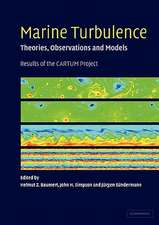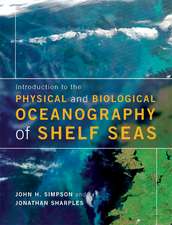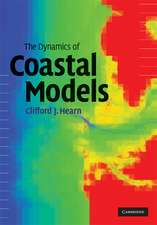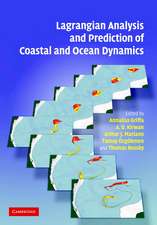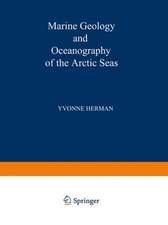The Physical Oceanography of Sea Straits: Nato Science Series C:, cartea 318
Editat de L.J. Pratten Limba Engleză Paperback – 3 noi 2011
Din seria Nato Science Series C:
- 24%
 Preț: 797.69 lei
Preț: 797.69 lei - 18%
 Preț: 957.62 lei
Preț: 957.62 lei - 18%
 Preț: 957.13 lei
Preț: 957.13 lei - 18%
 Preț: 1227.52 lei
Preț: 1227.52 lei -
 Preț: 396.40 lei
Preț: 396.40 lei -
 Preț: 403.75 lei
Preț: 403.75 lei - 18%
 Preț: 1239.37 lei
Preț: 1239.37 lei - 18%
 Preț: 1236.51 lei
Preț: 1236.51 lei - 18%
 Preț: 1231.78 lei
Preț: 1231.78 lei - 18%
 Preț: 1229.10 lei
Preț: 1229.10 lei - 18%
 Preț: 1835.21 lei
Preț: 1835.21 lei - 24%
 Preț: 1076.39 lei
Preț: 1076.39 lei -
 Preț: 390.46 lei
Preț: 390.46 lei -
 Preț: 369.63 lei
Preț: 369.63 lei - 18%
 Preț: 1232.41 lei
Preț: 1232.41 lei -
 Preț: 394.51 lei
Preț: 394.51 lei - 18%
 Preț: 1226.24 lei
Preț: 1226.24 lei - 18%
 Preț: 1845.80 lei
Preț: 1845.80 lei -
 Preț: 399.88 lei
Preț: 399.88 lei -
 Preț: 384.28 lei
Preț: 384.28 lei -
 Preț: 390.88 lei
Preț: 390.88 lei -
 Preț: 381.19 lei
Preț: 381.19 lei - 18%
 Preț: 1848.64 lei
Preț: 1848.64 lei - 18%
 Preț: 951.14 lei
Preț: 951.14 lei - 18%
 Preț: 1230.35 lei
Preț: 1230.35 lei - 18%
 Preț: 1236.51 lei
Preț: 1236.51 lei -
 Preț: 401.03 lei
Preț: 401.03 lei -
 Preț: 406.25 lei
Preț: 406.25 lei - 18%
 Preț: 1230.84 lei
Preț: 1230.84 lei -
 Preț: 418.34 lei
Preț: 418.34 lei - 18%
 Preț: 1223.74 lei
Preț: 1223.74 lei
Preț: 406.05 lei
Nou
Puncte Express: 609
Preț estimativ în valută:
77.71€ • 84.38$ • 65.27£
77.71€ • 84.38$ • 65.27£
Carte tipărită la comandă
Livrare economică 22 aprilie-06 mai
Preluare comenzi: 021 569.72.76
Specificații
ISBN-13: 9789401067898
ISBN-10: 9401067899
Pagini: 608
Ilustrații: 608 p.
Dimensiuni: 155 x 235 x 32 mm
Greutate: 0.84 kg
Ediția:Softcover reprint of the original 1st ed. 1990
Editura: SPRINGER NETHERLANDS
Colecția Springer
Seria Nato Science Series C:
Locul publicării:Dordrecht, Netherlands
ISBN-10: 9401067899
Pagini: 608
Ilustrații: 608 p.
Dimensiuni: 155 x 235 x 32 mm
Greutate: 0.84 kg
Ediția:Softcover reprint of the original 1st ed. 1990
Editura: SPRINGER NETHERLANDS
Colecția Springer
Seria Nato Science Series C:
Locul publicării:Dordrecht, Netherlands
Public țintă
ResearchCuprins
I. Case Studies.- Characteristics of Circulation in an Indonesian Archipelago Strait from Hydrography, Current Measurements and Modeling Results*Indicates peer-review paper.- On the Physical Oceanography of the Turkish Straits*.- A Review of the Physical Oceanography of Fram Strait*.- Tidal Currents and Transient Phenomena in the Strait of Messina: A Review*.- Measurements and Modelling in the Great Belt: A Unique Opportunity for Model Verification*.- Zero Blocking Solution for the Great Belt Link.- The Flow Through Vitiaz Strait and St. George’s Channel, Papua New Guinea.- A Review of Recent Physical Investigations on the Straits Around the Japanese Islands.- Influence of the Climatic Conditions on the Winter Fluxes in the Corsican Channel.- Long Term Current and Sea Level Measurements Conducted at Bosphorus.- WOCE and the Gibraltar Experiment Third Objective.- II. Hydraulics.- Hydraulic Models of Deep Stratified Flows over Topography*.- Is the Exchange Through the Strait of Gibraltar Maximal or Submaximal?*.- Aspiration of Deep Waters Through Straits*.- A Review of Rotating Hydraulics*.- Rotating Two-Layer Sill Flows*.- Role of Laboratory Experiments and Models in the Study of Sea Strait Processes*.- III. Waves, Tides and Time-Dependence.- Review of Dispersive and Resonant Effects in Internal Wave Propagation*.- Time-Dependent, Two-Layer Flow Over a Sill.- Long Progressive Waves in Rotating Fluid.- Characteristic Features Occurring in the Strait of Gibraltar as Seen Through Remote Sensing Data.- The Barotropic Tide in the Strait of Gibraltar.- Generation and Kinematics of the Internal Tide in the Strait of Gibraltar.- The Structure of the Internal Bore in the Strait of Gibraltar and Its Influence on the Atlantic Inflow.- Transients in the Nonlinear Adjustment toGeostrophy.- IV. Outflows, Turbulence and Mixing.- Can Mixing in Exchange Flows be Predicted Using Internal Hydraulics?*.- A Simple Model of the Descending Mediterranean Outflow Plume.- Friction in a Shallow Two-Layer Flow in a Rotating Ocean.- The Breakup of Outflows and the Formation of ‘Meddies’.- The Dynamics of Two Dimensional Turbulence.- V. Current Research Problems.- Current Research Problems.

